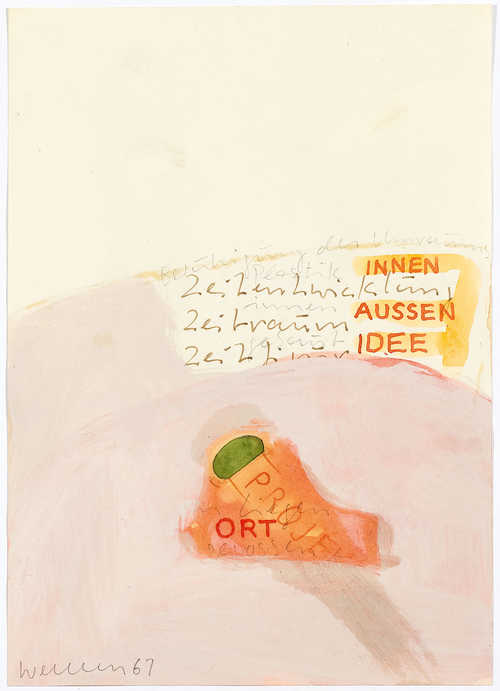
拍品 3424 - A185 战后和当代 - Samstag, 30. Juni 2018, 02.00 PM
FRANZ ERHARD WALTHER
(Fulda 1939–lives and works in Fulda)
Untitled. 1967.
Watercolor and pencil on paper (both sides).
Signed and dated lower left and on the reverse: Walther 67.
30 x 22 cm.
Provenance: Purchased by the present owner directly from the artist, since then private collection Switzerland.
Franz Erhard Walther’s entire oeuvre questions the traditional concept of sculpture. In his view, instead of traditional artworks, objects should be created which serve to narrate or communicate. The viewer of his works is encouraged to interact and experience the materials, the fabrics, the perceptions of their own body and their actions in the exhibition space. The artist has been engaged with this approach since the 1960s and between 1963 and 1969 he developed his well-known work “Werksatz 1”: a 58-piece series of usable objects, made out of cotton, wood or foam, which create geometric forms, and require the simple and calm movement of the viewer for the meaning to unfold. This work was first presented at MoMa in New York in 1969, at which time Franz Erhard Walther was considered one of the pioneers of participatory art and was one of the first artists to put Post War art behind them.
The “Werksatz 1” was accompanied by over 5000 drawings and diagrams, which served to explain to the viewers how to approach the objects. Later Franz Erhard Walther developed and adapted his ideas on handling to include hypothetical possibilities of handling, which is where the numerous drawings came in.
The two works on paper presented here belong to the so-called “Werkzeichnungen” (work drawings): double-sided works painted and annotated using the most diverse techniques (watercolour, gouache, coffee, pencil and coloured pencil, chalk and also some collage). The concepts of place, body, interior, exterior, space, time, direction, movement etc, are part of the most important vocabulary for the artist, by means of which he invites the viewer, through his thought process and relationship with the work, to engage in individual reflection.
Franz Erhard Walther was born in Fulda in 1939 and from 1957 to 1959 he studied at the school of arts and crafts in Offenbach am Main, and then until 1961 at the Frankfurt Academy of Fine Arts. From 1962 to 1964 he studied under Karl Otto Götz at the Art Academy in Dusseldorf along with Gerhard Richter and Sigmar Polke amongst others. Between 1967 and 1971 Walther lived in New York. After his return, at the age of just 32 he became a professor at the Art Academy of Hamburg. Since the early 2000s he has been living and working back in Fulda. The crowning moment of his many distinctions came in 2017 when he was awarded the Golden Lion at the 57th Venice Biennale.
Franz Erhard Walther’s entire oeuvre questions the traditional concept of sculpture. In his view, instead of traditional artworks, objects should be created which serve to narrate or communicate. The viewer of his works is encouraged to interact and experience the materials, the fabrics, the perceptions of their own body and their actions in the exhibition space. The artist has been engaged with this approach since the 1960s and between 1963 and 1969 he developed his well-known work “Werksatz 1”: a 58-piece series of usable objects, made out of cotton, wood or foam, which create geometric forms, and require the simple and calm movement of the viewer for the meaning to unfold. This work was first presented at MoMa in New York in 1969, at which time Franz Erhard Walther was considered one of the pioneers of participatory art and was one of the first artists to put Post War art behind them.
The “Werksatz 1” was accompanied by over 5000 drawings and diagrams, which served to explain to the viewers how to approach the objects. Later Franz Erhard Walther developed and adapted his ideas on handling to include hypothetical possibilities of handling, which is where the numerous drawings came in.
The two works on paper presented here belong to the so-called “Werkzeichnungen” (work drawings): double-sided works painted and annotated using the most diverse techniques (watercolour, gouache, coffee, pencil and coloured pencil, chalk and also some collage). The concepts of place, body, interior, exterior, space, time, direction, movement etc, are part of the most important vocabulary for the artist, by means of which he invites the viewer, through his thought process and relationship with the work, to engage in individual reflection.
Franz Erhard Walther was born in Fulda in 1939 and from 1957 to 1959 he studied at the school of arts and crafts in Offenbach am Main, and then until 1961 at the Frankfurt Academy of Fine Arts. From 1962 to 1964 he studied under Karl Otto Götz at the Art Academy in Dusseldorf along with Gerhard Richter and Sigmar Polke amongst others. Between 1967 and 1971 Walther lived in New York. After his return, at the age of just 32 he became a professor at the Art Academy of Hamburg. Since the early 2000s he has been living and working back in Fulda. The crowning moment of his many distinctions came in 2017 when he was awarded the Golden Lion at the 57th Venice Biennale.
CHF 2 000 / 3 000 | (€ 2 060 / 3 090)
以瑞士法郎銷售 CHF 2 500 (包含買家佣金)
所有信息随时可能更改。
